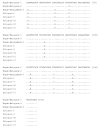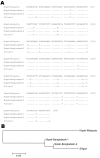Nipah virus-associated encephalitis outbreak, Siliguri, India
- PMID: 16494748
- PMCID: PMC3373078
- DOI: 10.3201/eid1202.051247
Nipah virus-associated encephalitis outbreak, Siliguri, India
Abstract
During January and February 2001, an outbreak of febrile illness associated with altered sensorium was observed in Siliguri, West Bengal, India. Laboratory investigations at the time of the outbreak did not identify an infectious agent. Because Siliguri is in close proximity to Bangladesh, where outbreaks of Nipah virus (NiV) infection were recently described, clinical material obtained during the Siliguri outbreak was retrospectively analyzed for evidence of NiV infection. NiV-specific immunoglobulin M (IgM) and IgG antibodies were detected in 9 of 18 patients. Reverse transcription-polymerase chain reaction (RT-PCR) assays detected RNA from NiV in urine samples from 5 patients. Sequence analysis confirmed that the PCR products were derived from NiV RNA and suggested that the NiV from Siliguri was more closely related to NiV isolates from Bangladesh than to NiV isolates from Malaysia. NiV infection has not been previously detected in India.
Figures




References
-
- ICDDRB. Nipah encephalitis outbreak over wide area of western Bangladesh. Health Science Bulletin. 2004;2:7–11.
-
- ICDDRB. Person-to-person transmission of Nipah virus during outbreak in Faridpur District. Health Science Bulletin. 2004;2:5–9.
-
- World Health Organization. Nipah virus outbreak(s) in Bangladesh, January–April 2004. Wkly Epidemiol Rec. 2004;17:168–71. - PubMed
MeSH terms
Substances
LinkOut - more resources
Full Text Sources
